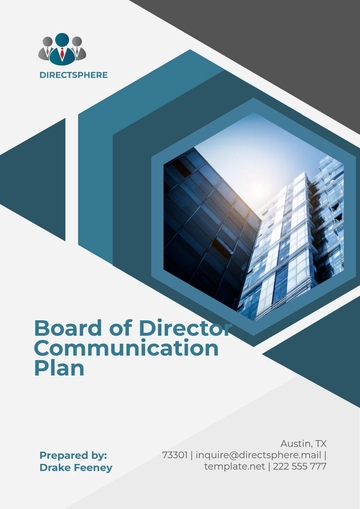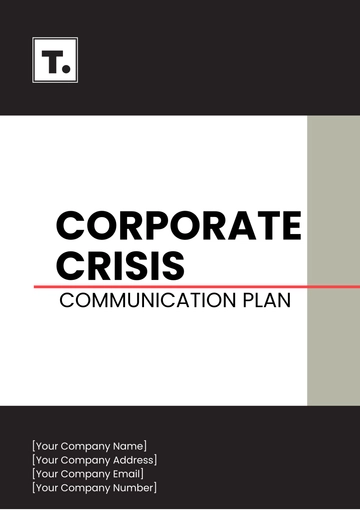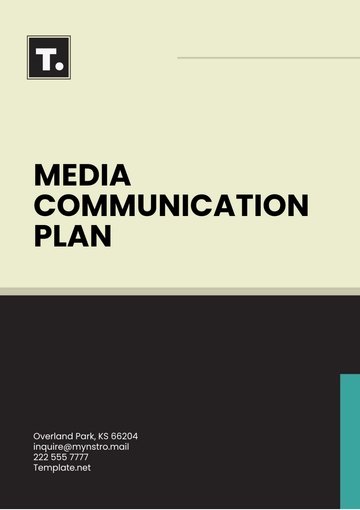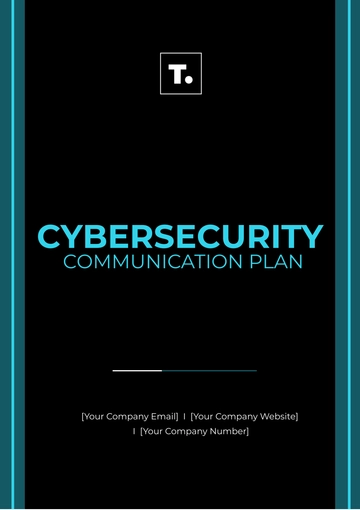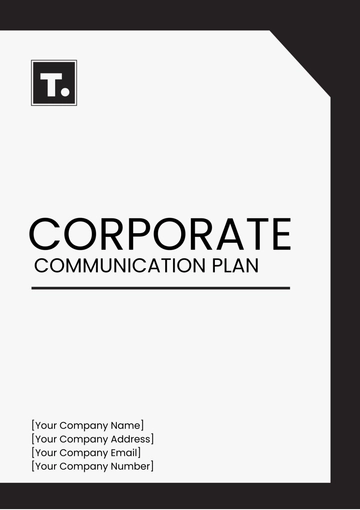Free Crisis Management and Communication Plan HR

Purpose
In a constantly changing business environment, unforeseen challenges can emerge, leading to situations that demand immediate and effective responses. A crisis, whether internal or external, can have a profound effect on the day-to-day operations, reputation, and overall well-being of [Company Name]. Recognizing this potential, it is crucial for [Company Name] to be prepared to respond swiftly and efficiently.
This Crisis Management and Communication Plan is designed to guide our organization through such times, ensuring the safety and well-being of our employees, preserving our reputation, and providing clear and consistent communication to all relevant stakeholders.
Objective
The primary objective of this plan is to outline the necessary procedures and communication strategies [Company Name] will employ during a crisis. By defining clear roles, responsibilities, and communication channels, we aim to:
Ensure the safety and well-being of all our employees and stakeholders.
Maintain open and transparent channels of communication, both internally among employees and externally with our stakeholders and the public.
Address the crisis with a structured and coordinated approach, minimizing disruption and damage.
Re-establish normal operations and assess areas for improvement in our response, ensuring the continued growth and resilience of [Company Name].
By adhering to the guidelines set forth in this plan, [Company Name] seeks to navigate any crisis with clarity, confidence, and effectiveness.
Definition of Crisis
For the purpose of this plan, a crisis is defined as any unforeseen situation or event that poses a significant threat to the operations, reputation, or stability of [Company Name]. The following table contains the potential crises, their likelihood and impact levels.
Crisis Type | Likelihood | Impact | Impact Description |
Cybersecurity Breach | High | Severe | Data theft, service disruption, and reputational damage |
Natural Disaster | Medium | High - Severe | Disrupt operations, damage assets, and endanger employee safety |
Financial Crisis | Medium | Severe | Jeopardize the company's stability |
PR Scandal | Medium | High | Tarnish the company's reputation, impacting trust and revenue |
Product Failure | Low | High | Recalls, litigation, and brand damage |
Supply Chain Disruption | Medium | High | Halt production and delivery |
Regulatory Changes | Low | Medium | Impose unforeseen costs or require business model changes |
Crisis Management Team (CMT)
In the event of a crisis, it is paramount to have a dedicated team in place to navigate, manage, and communicate the situation. The Crisis Management Team (CMT) is a select group of individuals trained and tasked with the responsibility of responding effectively to a crisis. Their primary roles include assessing the situation, coordinating responses, making crucial decisions, and communicating with both internal and external stakeholders.
Role/Position | Name | Contact Number | |
CMT Lead | [Name] | [Email] | [Number] |
Communication Lead | [Name] | [Email] | [Number] |
Operations Coordinator | [Name] | [Email] | [Number] |
External Affairs | [Name] | [Email] | [Number] |
[Additional Role] | [Name] | [Email] | [Number] |
Communication Protocols
Clear and timely communication is paramount during a crisis. Proper channels must be established to prevent misinformation, reduce panic, and ensure all stakeholders are informed about the situation and any necessary actions they should take.
Internal Communication
The CMT Lead or designated representative will inform all CMT members of the crisis as soon as it is identified.
The Communication Lead will draft and disseminate crisis updates and directives to all employees via [method].
A mechanism should be in place for employees to relay information, concerns, or observations relevant to the crisis back to the CMT.
External Communication
Only designated spokespersons, as listed in the CMT roster, are authorized to communicate with the media and the public to ensure consistent messaging.
All public-facing communications, such as press releases or social media statements, will be approved by the CMT Lead or the Communication Lead.
Action Steps
When a crisis arises, it is crucial to have a structured approach for responding. The following action steps provide a roadmap for the CMT to navigate the crisis effectively from detection to recovery.
Step | Description | Responsible |
Detection |
| All CMT Members |
Assessment |
| CMT Lead, Operations Coordinator |
Response |
| All CMT Members |
Communication |
| Communication Lead |
Recovery |
| Operations Coordinator |
Review |
| All CMT Members |
Training and Drills
To ensure the effectiveness of this crisis management plan and to maintain a state of readiness, regular training and drills are essential. Familiarity with the plan and rehearsing response procedures will enhance our organization's ability to manage and mitigate the effects of a crisis.
Type | Frequency | Facilitator | Schedule |
Crisis Management Training | Annually | CMT Member/External Consultant | [Date] |
Communication Protocol Training | Bi-annually | Communication Lead/PR Expert | [Date] |
Data Breach Drill | Annually | IT Lead/External Cybersecurity Firm | [Date] |
Natural Disaster Drill | Bi-annually | Health & Safety Officer/External Safety Consultant | [Date] |
Based on feedback from training sessions and drills, the CMT will regularly review and update the plan to address any gaps, ensure its relevance, and incorporate any new best practices in crisis management.
Budget
To ensure an effective response during a crisis, it's crucial that we allocate funds in advance for potential expenses. The following budget estimates consider various facets of crisis management.
Training & Drills | $XX,XXX |
Communication Infrastructure | $XX,XXX |
External Consultancy | $XX,XXX |
Legal & Compliance | $XX,XXX |
Operational Continuity | $XX,XXX |
Public Relations Management | $XX,XXX |
Health & Safety | $XX,XXX |
Miscellaneous | $XX,XXX |
Total Budget | $XXX,XXX |
Review
Regular reviews of the Crisis Management and Communication Plan are essential to ensure its continued relevance and effectiveness. As [Company Name] evolves, the potential risks and challenges we face might change, necessitating updates to our approach.
Frequency: The Crisis Management and Communication Plan will be reviewed annually. However, additional reviews can be initiated after the resolution of any crisis event or significant internal change to assess the plan's effectiveness and identify areas for improvement.
Review Committee: While the CMT will primarily be responsible for the review process, input should also be sought from various departments within [Company Name] to ensure a comprehensive understanding of potential risks and challenges.
Documentation: Any modifications made to the plan post-review will be documented clearly, with older versions archived for reference. This ensures a clear record of changes and the evolution of the plan over time.
Communication: Post-review, any significant changes or updates to the plan will be communicated to all employees to ensure everyone remains informed and aligned with the updated procedures and protocols.
- 100% Customizable, free editor
- Access 1 Million+ Templates, photo’s & graphics
- Download or share as a template
- Click and replace photos, graphics, text, backgrounds
- Resize, crop, AI write & more
- Access advanced editor
The Crisis Management and Communication Plan HR Template from Template.net is a must-have for organizations seeking to prepare for unforeseen events. Fully editable and customizable, this template enables HR professionals to develop a comprehensive plan that addresses various crisis scenarios. Adapt it to your organization's specific needs using our AI Editor tool, ensuring effective communication and management during critical times.



